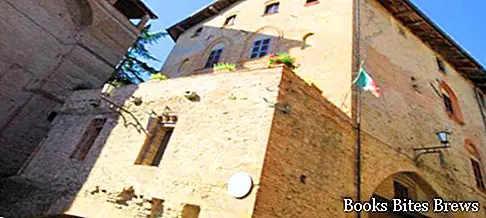What to see in Castell’Arquato, itinerary including the main monuments and places of interest, including Collegiata Santa Maria Assunta and Rocca Viscontea.
Tourist information
Strategically located on the first hills of the Val D’Arda, Castell’Arquato is a medieval village perched along the hill, in a dominant position over the surrounding landscape.
Originally inhabited by Ligurian populations, the territory of Castell’Arquato underwent significant transformations under the domination of the Romans, who built numerous defensive works there.
Over time the village has kept intact the characteristics of the medieval period, to which the main monuments and the urban structure date back.
The Collegiate Church of Santa Maria Assunta, which dates back to around 758 and was rebuilt in 1122, has an interior with three naves, separated by sandstone columns and covered with trusses.
In the Chapel of Santa Caterina d'Alessandria, which dates back to the early 1400s, paintings from the Tuscan school are preserved, depicting a cycle of the Passion of Jesus and the funeral of the Virgin Mary.
The chapel of San Giuseppe of 1630, dedicated to the city patron and built on top of a previous chapel, has a predominantly Baroque style, decorated with stuccos and paintings, including the lateral paintings by Giacomo Guidotti, which represent the Marriage of Mary and the Nativity of Gesà, in addition to an altarpiece from 1720 depicting the Holy Family.
The cloister of the collegiate was built between the thirteenth and sixteenth centuries, while the bell tower dates back to the thirteenth century.
What see
The Duke's palace, which was built by Alberto Scoto in 1292, as confirmed by an inscription engraved in the foundations of the Montaguzzo fountain, was rebuilt several times in subsequent periods, as confirmed by the fifteenth-century style windows.
In the past, from this building a corridor used to connect it to the nearby Torrione.
Like the previous one, the Palazzo del Podestà was also erected in 1293 by Alberto Scoto.
Recommended readings- Brisighella (Emilia Romagna): what to see
- Grazzano Visconti (Emilia Romagna): what to see
- Castelnovo ne ’Monti (Emilia Romagna): what to see
- Canossa (Emilia Romagna): what to see
- Emilia Romagna: Sunday day trips
The three-storey building, topped with battlements, includes a pentagonal tower with two large clocks.
In about 1400 the Palazzo del Podestà was enlarged, adding the loggia dei notari and a second wing on the side of the square.
Inside there is the council room, which includes fine decorations on the walls and a coffered ceiling.
The Torrione Farnese, which has kept intact the typical appearance of sixteenth-century military buildings, is square in shape, about twenty meters high and equipped with four bulwarks placed at its corners.
Within three bulwarks there are octagonal shaped rooms, while in the fourth there is a spiral staircase.
In the central body there is a hall covered by a vault, communicating with the octagonal rooms located in the first three bulwarks.
This defensive construction was probably started in 1527 by Bosio II, Count of S.Fiora, and finished in 1545 by Sforza.
The Visconti fortress, which was built in 1342 on the site of a previous fortress, was later modified by Luchino Visconti, who added the high tower, to have a dominant view of the town and the Arda valley.
From Piazza Matteotti you can easily reach the ancient Santo Spirito Hospital which, dating back to the sixteenth century, houses the Cortesi Geological Museum.




